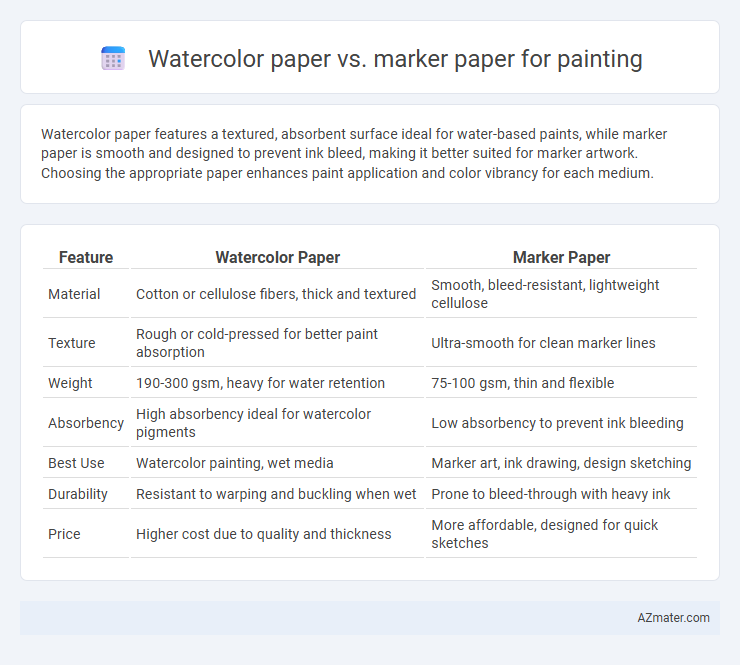Watercolor paper features a textured, absorbent surface ideal for water-based paints, while marker paper is smooth and designed to prevent ink bleed, making it better suited for marker artwork. Choosing the appropriate paper enhances paint application and color vibrancy for each medium.
Table of Comparison
| Feature | Watercolor Paper | Marker Paper |
|---|---|---|
| Material | Cotton or cellulose fibers, thick and textured | Smooth, bleed-resistant, lightweight cellulose |
| Texture | Rough or cold-pressed for better paint absorption | Ultra-smooth for clean marker lines |
| Weight | 190-300 gsm, heavy for water retention | 75-100 gsm, thin and flexible |
| Absorbency | High absorbency ideal for watercolor pigments | Low absorbency to prevent ink bleeding |
| Best Use | Watercolor painting, wet media | Marker art, ink drawing, design sketching |
| Durability | Resistant to warping and buckling when wet | Prone to bleed-through with heavy ink |
| Price | Higher cost due to quality and thickness | More affordable, designed for quick sketches |
Introduction: Understanding Paper Types for Painting
Watercolor paper features a textured surface and high absorbency designed to handle wet media, preventing warping and allowing pigment to spread naturally. Marker paper is smooth, less absorbent, and optimized for ink, providing crisp lines without bleeding, ideal for detailed illustrations. Choosing the right paper impacts paint application, drying time, and final artwork quality, making material knowledge essential for artists.
What is Watercolor Paper?
Watercolor paper is specifically designed to handle the intense moisture and fluidity of watercolor paints, featuring a thicker, more absorbent surface made from cotton or cellulose fibers. Its textured surface, often categorized as hot-pressed, cold-pressed, or rough, allows for varying paint effects and better pigment retention. Unlike marker paper, which is smooth and less absorbent to prevent bleed-through, watercolor paper supports water-based media by soaking up water without warping or tearing.
What is Marker Paper?
Marker paper is a smooth, bleed-proof surface designed specifically for alcohol-based markers, allowing colors to blend seamlessly without feathering or soaking through. Unlike watercolor paper, which has a textured, absorbent surface ideal for water-based paints to create gradients and depth, marker paper maintains crisp lines and vibrant colors. It is thinner and less textured, making it ideal for illustrations, fashion design, and graphic work but unsuitable for heavy water or wet media.
Key Differences in Paper Texture
Watercolor paper features a highly textured surface designed to absorb water and pigment, enhancing blending and color depth in paintings. Marker paper, however, has a smooth, non-absorbent finish that prevents ink bleed, ensuring sharp and precise lines for marker artwork. The texture differences significantly impact how each paper handles mediums, making watercolor paper ideal for fluid techniques and marker paper better suited for controlled, detailed work.
Absorption and Bleed-Through: How Each Paper Performs
Watercolor paper features high absorption due to its textured and porous surface, allowing it to hold multiple layers of wet paint without significant bleed-through, making it ideal for water-based mediums. Marker paper, typically smooth and less absorbent, prevents ink from spreading, reducing bleed-through but can cause colors to sit on the surface, which may lead to smudging or uneven coverage. Comparing both, watercolor paper excels in managing wetness and pigment retention, while marker paper offers controlled bleeding suitable for detailed marker work.
Durability and Weight: Which Lasts Longer?
Watercolor paper, typically made from cotton or wood pulp, offers superior durability and can withstand multiple washes without warping or tearing, making it ideal for heavy paint applications and long-lasting artwork. Marker paper, usually thinner and smooth, is designed for bleed-resistant performance but tends to be less durable and prone to curling or degradation over time, especially with heavy ink layers. For longevity and weight-bearing capacity, watercolor paper outperforms marker paper, maintaining structural integrity and color vibrancy in the long term.
Suitability for Different Painting Techniques
Watercolor paper features a textured surface and high absorbency that enhances the flow and blending of water-based paints, making it ideal for techniques like wet-on-wet and layering washes. Marker paper offers a smooth, bleed-resistant surface optimized for markers and ink, supporting precise lines and vibrant colors without feathering. Artists choose watercolor paper for fluid, expressive effects and marker paper for sharp, controlled illustrations, depending on their preferred painting technique.
Color Vibrancy and Blending Results
Watercolor paper features a textured surface that absorbs pigment, enhancing color vibrancy by allowing rich, deep hues to develop and facilitating smooth blending with water-based paints. Marker paper, often smooth and coated, prevents ink from bleeding but can limit color saturation and blending, leading to more vivid but less gradient-rich results. Choosing watercolor paper maximizes blending possibilities and subtle color transitions, while marker paper excels in maintaining crisp, bright colors with minimal feathering.
Cost Comparison: Watercolor Paper vs Marker Paper
Watercolor paper generally costs more than marker paper due to its thicker weight and higher durability, which supports heavy washes without warping. Marker paper is typically thinner and more affordable, designed specifically to prevent bleeding and feathering of alcohol or water-based markers. Artists seeking budget-friendly options for light marker work usually prefer marker paper, while those requiring longevity and versatility invest in the relatively pricier, sturdy watercolor paper.
Choosing the Right Paper for Your Art Style
Watercolor paper features a textured surface and high absorbency, ideal for fluid techniques and vibrant color blending, whereas marker paper is smooth and bleed-resistant, perfect for precise line work and layering with alcohol-based markers. Artists using watercolors benefit from thicker, cold-pressed cellulose or cotton papers, while those working with markers prefer vellum or bleed-proof papers designed to prevent ink spread. Selecting the right paper depends on your preferred medium, technique, and desired finish to enhance the durability and appearance of your artwork.

Infographic: Watercolor paper vs Marker paper for Painting
 azmater.com
azmater.com